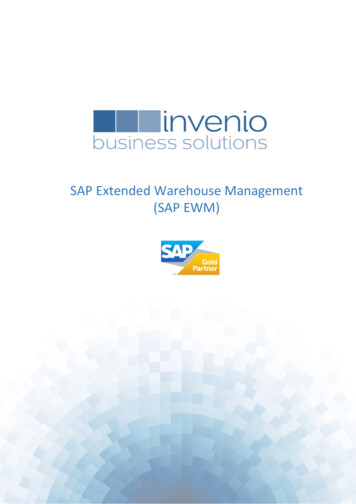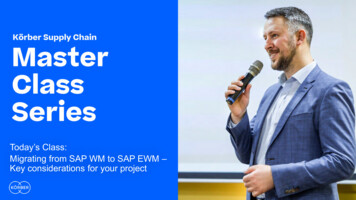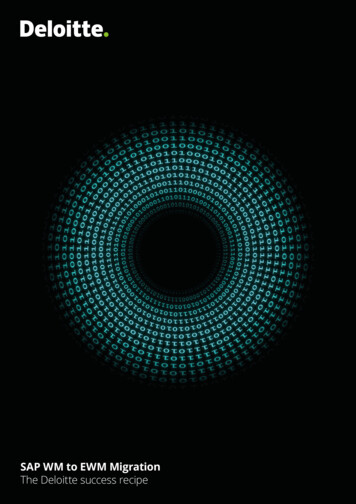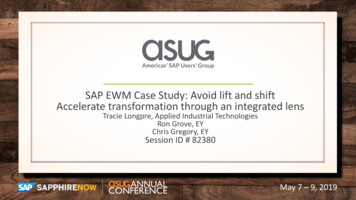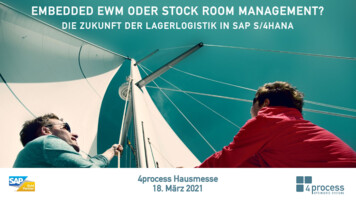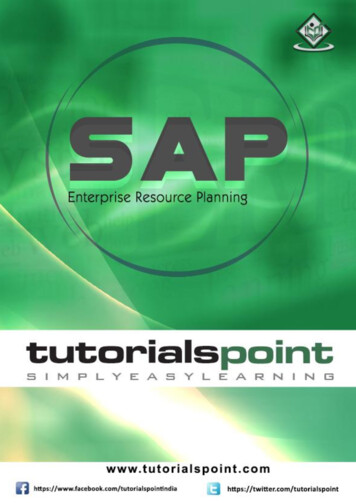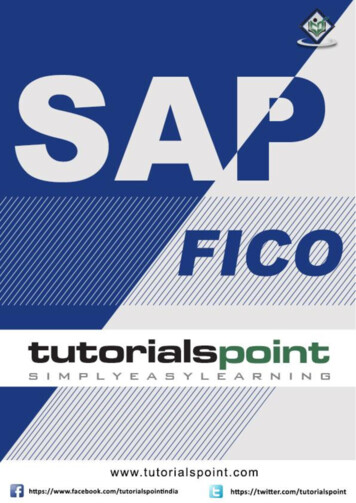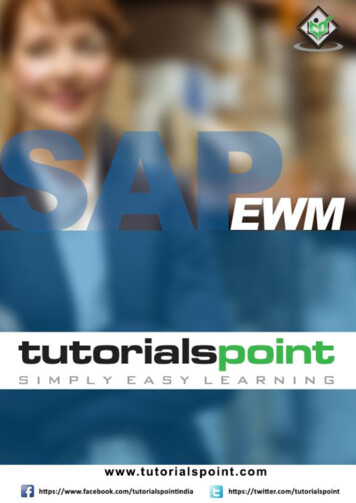
Transcription
SAP EWMAbout the TutorialSAP EWM is part of SAP Supply Chain Management like Warehouse Management System,but it provides more robust and advanced features to manage key activities in awarehouse.SAP EWM is used to efficiently manage inventory in a Warehouse and for supportingprocessing of goods movement. It allows any company to control their Warehouse’sinbound and outbound processes and movement of goods in the Warehouse.This is a fundamental tutorial that covers the basics of SAP EWM and how to deal with itsvarious components and sub-components.AudienceIn SAP EWM all goods movement are controlled by the warehouse management systemthat provides you the tools to monitor warehouse activities. This tutorial has been preparedfor all those professionals who wish to learn the fundamentals of SAP EWM and to executeit in practice.PrerequisitesIt is a straightforward and simple tutorial which the readers can easily understand. Theconceptions are explained here with a basic knowledge of how a company or anorganization deals with its Warehouse Management System. However, it will help if youhave some prior exposure to vendor management inventory, resource optimization, valueadded services and other related activities.Copyright and Disclaimer Copyright 2018 by Tutorials Point (I) Pvt. Ltd.All the content and graphics published in this e-book are the property of Tutorials Point (I)Pvt. Ltd. The user of this e-book is prohibited to reuse, retain, copy, distribute or republishany contents or a part of contents of this e-book in any manner without written consentof the publisher.We strive to update the contents of our website and tutorials as timely and as precisely aspossible, however, the contents may contain inaccuracies or errors. Tutorials Point (I) Pvt.Ltd. provides no guarantee regarding the accuracy, timeliness or completeness of ourwebsite or its contents including this tutorial. If you discover any errors on our website orin this tutorial, please notify us at contact@tutorialspoint.comi
SAP EWMTable of ContentsAbout the Tutorial . iAudience . iPrerequisites . iCopyright and Disclaimer . iTable of Contents . ii1.SAP EWM – OVERVIEW . 1SAP EWM is different from SAP Warehouse Management . 1SAP EWM: Key Features . 2Deployed Options in SAP EWM . 2Communication Method . 32.SAP EWM – ORGANIZATION UNITS . 5Types of Organization Units . 5How to Create Storage Bins and Block them for Put Away? . 6How to change the Storage Bin? . 93.SAP EWM – MASTER DATA . 11Create and Update the WPM in ERP and SCM . 12Create WPM for Material Master Record Transfer via CIF? . 164.SAP EWM – STRUCTURE ELEMENTS . 20Types of Structure Elements. 20Storage Types . 215.SAP EWM – WORK CENTER . 23Creating a Work Center . 236.SAP EWM – WAREHOUSE PROCESS TYPES . 26ii
SAP EWM7.SAP EWM – SELLING AND RECEIVING GOODS . 288.SAP EWM – MAINTAINING SERIAL NUMBERS. 30Types of Serial Number Profiles . 309.SAP EWM – VALUE ADDED SERVICES . 32Value Added Services Order . 32How to Manage Packaging Specifications? . 33How to Confirm a VAS order and Processing of a Handling Unit? . 3410. SAP EWM – DIRECT GOODS ISSUE PROCESS . 36How is a Goods Issue Carried out? . 36Parameters to Perform a Storage Type Search Sequence . 37Stock Removal Strategies . 38Denial Scenario . 39Waves in Warehouse for Outbound Delivery . 3911. SAP EWM – STORAGE CONTROL . 41Types of Storage Control . 4112. SAP EWM – DECONSOLIDATION . 4413. SAP EWM – PICK, PACK AND PASS OF GOODS . 4514. SAP EWM – REPLENISHMENT . 46Types of Replenishment . 46How to Perform a Planned Replenishment? . 47How to Find out the Assigned Fixed Bin?. 50How to Perform Replenishment? . 5215. SAP EWM – PHYSICAL INVENTORY . 55Benefits of Physical Inventory . 55iii
SAP EWMAd-hoc Inventory . 55How to Create an Ad-Hoc Physical Inventory Document? . 5716. SAP EWM – SLOTTING . 60Different Parameters of Slotting . 6017. SAP EWM – LABOR MANAGEMENT . 62How to Create a Processor Business Partner? . 6418. SAP EWM – PRODUCTION SUPPLY. 67How to Setup a Master Data for Production Supply Process?. 6719. SAP EWM – EXPECTED GOOD RECEIPTS . 71Advantages of Using a Good Receipt . 71Create a Document for Expected Goods Receipt in EWM (Pull)? . 71How to Check the Expected Goods Receipt Document? . 7420. SAP EWM – CROSS DOCKING. 76Performing Opportunistic Cross Docking . 7621. SAP EWM – RF FRAMEWORK . 8122. SAP EWM – WAREHOUSE MONITORING . 82Warehouse Monitor Components . 82How to Display Stock Balance? . 8423. SAP EWM – INBOUND AND OUTBOUND DELIVERY . 86How to Open a Purchase Order for Inbound Query? . 86How to Create an Inbound Delivery? . 89iv
1. SAP EWM – OverviewSAP EWMSAP Extended Warehouse Management (EWM) is used to efficiently manage inventory inthe Warehouse and for supporting processing of goods movement. It allows the companyto control their Warehouse inbound and outbound processes and movement of goods inthe Warehouse.The main process in a Warehouse is incoming and outgoing materials, goods receipt andgoods issue, fulfil customer orders, and distribution of goods. When a company doesn’tstore any goods, then there is no need of Warehouse management to manage goods.Inbound process involves storage of goods in warehouse and their location and Outboundprocess involves picking up the goods. Whenever a material is stored in a warehouse, it isstored in the storage bin and you can find its current location.With the help of SAP EWM all the goods movement are controlled by a warehousemanagement system and provides you the tools to monitor warehouse activities. You canalso manage additional functions in the Warehouse like creating a serial number, batchnumber, vendor management inventory, resource optimization and value added services.SAP Extended Warehouse Management allows you to not only monitor the quantity ofgoods in Warehouse but to manage other critical functions and delivery of goods efficiently.SAP Warehouse Management is opposite to Inventory management. Inventorymanagement tells the count of goods in the storage location and its physical location isunknown. Warehouse management deals with goods movement and monitoring thephysical location of the goods recorded with specific documents.SAP EWM is different from SAP Warehouse ManagementSAP EWM is a part of SAP Supply Chain Management like Warehouse management systembut provides more robust and advanced features to manage key activities in theWarehouse.SAP Extended Warehouse Management is similar to Warehouse management but itprovides more features like picking, put away, RF framework, Warehouse structure andmore flexible options to manage the warehouse functions.You can create new elements like an activity area, resources, labor management and workcenters in SAP EWM which were not available in WM.SAP EWM provides more a robust solution to manage warehouse functions in anorganization. It is also a part of SAP Supply Chain Management and also supports all theprocesses within logistics and supply chain.1
SAP EWMSAP EWM Key FeaturesThe following are the key features in SAP EWM: Using SAP EWM, you can control the warehouse activities like picking, posting andmanaging storage bin and good receipts. You can set alert for changed data before goods receipt from EWM to the ERPsystem, reversal or correction of the goods receipt from EWM to the ERP systemand an inbound delivery split from EWM to the ERP system. You can perform deconsolidation of handling units which contain different productsbefore putting them away in different storage sections. You can determine st
SAP Extended Warehouse Management is integrated with ERP to access transaction and master data and use of features like slotting, availability check also requires its integration with CRM. SAP EWM 3 It is considered as a separate application and shares the same server with the SCM applications. You can also run SAP EWM in its own SCM environment which is suitable to get improved performance .
